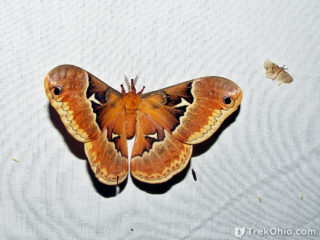 Mothapalooza is an annual conference sponsored by the Ohio Division of Wildlife. As its name suggests, the focus on the conference is on moths. Just like people who go bird-watching are said to go "birding," people who are on the lookout for moths are said to go "mothing." The conference is geared both toward the mothing enthusiast and the beginner. Activities included daytime field trips, in-house talks, and night-time moth viewings. Some of the daytime field-trips delved into other topics besides Read more ➜
Mothapalooza is an annual conference sponsored by the Ohio Division of Wildlife. As its name suggests, the focus on the conference is on moths. Just like people who go bird-watching are said to go "birding," people who are on the lookout for moths are said to go "mothing." The conference is geared both toward the mothing enthusiast and the beginner. Activities included daytime field trips, in-house talks, and night-time moth viewings. Some of the daytime field-trips delved into other topics besides Read more ➜ Mothapalooza 2016: Learning about moths
 Mothapalooza is an annual conference sponsored by the Ohio Division of Wildlife. As its name suggests, the focus on the conference is on moths. Just like people who go bird-watching are said to go "birding," people who are on the lookout for moths are said to go "mothing." The conference is geared both toward the mothing enthusiast and the beginner. Activities included daytime field trips, in-house talks, and night-time moth viewings. Some of the daytime field-trips delved into other topics besides Read more ➜
Mothapalooza is an annual conference sponsored by the Ohio Division of Wildlife. As its name suggests, the focus on the conference is on moths. Just like people who go bird-watching are said to go "birding," people who are on the lookout for moths are said to go "mothing." The conference is geared both toward the mothing enthusiast and the beginner. Activities included daytime field trips, in-house talks, and night-time moth viewings. Some of the daytime field-trips delved into other topics besides Read more ➜ 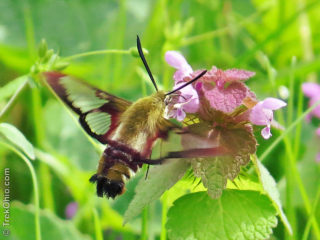 This little creature is my favorite moth. It's common name is actually the hummingbird clearwing moth (Hemaris thysbe). When I first saw one, I actually thought that I was seeing a hummingbird flitting about from flowers. But then I noticed the antenna.
In the above photo, you can see right through the moth's wings, hence the name "clearwing." However when it first emerged from its cocoon, the wings were a solid, dark red similar in color to the border of the wings seen above. The
This little creature is my favorite moth. It's common name is actually the hummingbird clearwing moth (Hemaris thysbe). When I first saw one, I actually thought that I was seeing a hummingbird flitting about from flowers. But then I noticed the antenna.
In the above photo, you can see right through the moth's wings, hence the name "clearwing." However when it first emerged from its cocoon, the wings were a solid, dark red similar in color to the border of the wings seen above. The 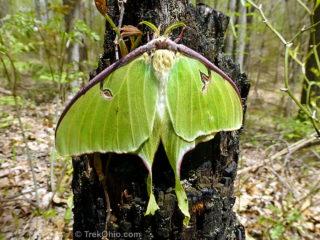 While hiking at Tar Hollow this past weekend, we spotted a Luna moth perched on a burnt tree trunk. After studying its photo I realized that we now had photos of both the male and female Luna moth, so I thought I would share with you how to tell the difference between the two genders, plus provide a little background information on this moth. However when I showed the photo to some other people, they were soon telling me that the moth looked like it was about two feet wide. So before going on, try
While hiking at Tar Hollow this past weekend, we spotted a Luna moth perched on a burnt tree trunk. After studying its photo I realized that we now had photos of both the male and female Luna moth, so I thought I would share with you how to tell the difference between the two genders, plus provide a little background information on this moth. However when I showed the photo to some other people, they were soon telling me that the moth looked like it was about two feet wide. So before going on, try 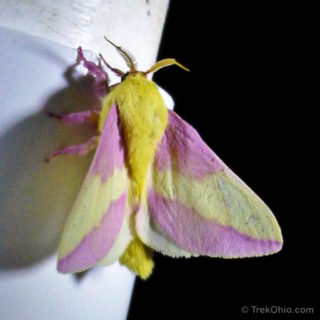 When people go out looking for birds, they are birding, while those who are looking for moths are mothing. More amusingly, those who engage in mothing are called mothers; however, the word is often hyphenated as moth-ers to highlight its different meaning and pronunciation.
When we were invited to attend a private mothing event at the Wahkeena Nature Preserve, we decided to give it a try. We really weren't sure how to go about it or what to expect, but Robyn and Tom of the preserve, as well as
When people go out looking for birds, they are birding, while those who are looking for moths are mothing. More amusingly, those who engage in mothing are called mothers; however, the word is often hyphenated as moth-ers to highlight its different meaning and pronunciation.
When we were invited to attend a private mothing event at the Wahkeena Nature Preserve, we decided to give it a try. We really weren't sure how to go about it or what to expect, but Robyn and Tom of the preserve, as well as 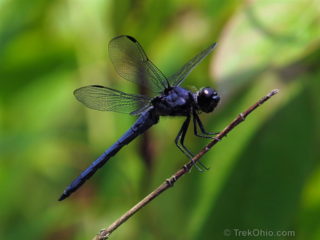 There are lots of reasons to like dragonflies. A great reason to like them is that they are voracious eaters of mosquitoes. Another is that they are one of the most skillful fliers in the animal kingdom: with their two pairs of parallel wings, they can hover or fly in any direction, even backwards or side-to-side. Dragonflies are also one of the fastest flying insects; they reach speeds up to 34 mph (a famous entomologist, Robert John Tillyard, claims to have observed one dragonfly flying at 60 mph).
There are lots of reasons to like dragonflies. A great reason to like them is that they are voracious eaters of mosquitoes. Another is that they are one of the most skillful fliers in the animal kingdom: with their two pairs of parallel wings, they can hover or fly in any direction, even backwards or side-to-side. Dragonflies are also one of the fastest flying insects; they reach speeds up to 34 mph (a famous entomologist, Robert John Tillyard, claims to have observed one dragonfly flying at 60 mph). 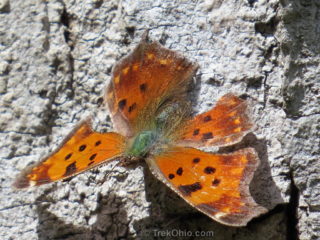 A short while ago I did a post on the Mourning Cloak butterfly. One of the odd things about this butterfly is that it looks like it only has four feet, but it actually has six feet like most insects. It's just that the front two are tiny, little things that the butterfly holds near its body. Someone thought the fuzzy, front feet looked like brushes, so that's how an entire family of butterfly species became known as the Brushfoot family. Today I'm going to look at two other species that are members
A short while ago I did a post on the Mourning Cloak butterfly. One of the odd things about this butterfly is that it looks like it only has four feet, but it actually has six feet like most insects. It's just that the front two are tiny, little things that the butterfly holds near its body. Someone thought the fuzzy, front feet looked like brushes, so that's how an entire family of butterfly species became known as the Brushfoot family. Today I'm going to look at two other species that are members 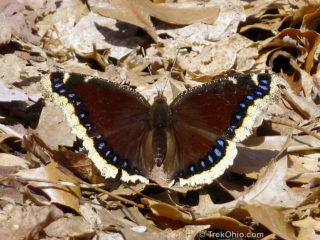 A few days ago, I was able to photograph my first butterfly of the year, a Mourning Cloak Butterfly. The reason the outer edges of its wings are frayed already is because it has been hanging out in Ohio all winter… well, not exactly hanging out. When it's very cold, this butterfly sneaks into a crack in a tree or some other little nook and hibernates there until it gets warmer. And it doesn't necessarily wait till spring. Whenever we are having unseasonably warm, winter weather, there is some chance
A few days ago, I was able to photograph my first butterfly of the year, a Mourning Cloak Butterfly. The reason the outer edges of its wings are frayed already is because it has been hanging out in Ohio all winter… well, not exactly hanging out. When it's very cold, this butterfly sneaks into a crack in a tree or some other little nook and hibernates there until it gets warmer. And it doesn't necessarily wait till spring. Whenever we are having unseasonably warm, winter weather, there is some chance 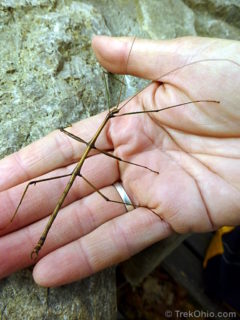 I was in luck as I approached the Nature Center at Blendon Woods Metro Park in Columbus. A staff member told me that she was just about to release a walking stick into the wild, and she asked me if I'd like to watch. You'll note that the insect above has a pincer like appendage at the end of its abdomen. She explained to me that this meant this particular insect was a male walking stick. The appendage is used to grip the female while mating. Another difference between the sexes is that the male is
I was in luck as I approached the Nature Center at Blendon Woods Metro Park in Columbus. A staff member told me that she was just about to release a walking stick into the wild, and she asked me if I'd like to watch. You'll note that the insect above has a pincer like appendage at the end of its abdomen. She explained to me that this meant this particular insect was a male walking stick. The appendage is used to grip the female while mating. Another difference between the sexes is that the male is 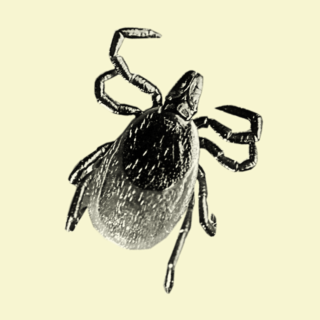 Although Ohio has a number of tick species, the species which carries Lyme disease has been relatively absent from our state… until now. The Lyme-carrying tick is the Black Legged Tick, also known as the Deer Tick (Ixodes scapularis). There are now established populations of Black Legged Ticks in 26 Ohio counties including Franklin and Delaware counties in Central Ohio. Most of the affected counties are east of Interstate 71 (see the link to the Toledo Blade at the end of this post for a map of
Although Ohio has a number of tick species, the species which carries Lyme disease has been relatively absent from our state… until now. The Lyme-carrying tick is the Black Legged Tick, also known as the Deer Tick (Ixodes scapularis). There are now established populations of Black Legged Ticks in 26 Ohio counties including Franklin and Delaware counties in Central Ohio. Most of the affected counties are east of Interstate 71 (see the link to the Toledo Blade at the end of this post for a map of 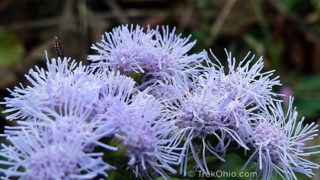 There's a crab spider lurking in the cluster of flowers pictured above. Crab spiders pretend to be part of a flower, and when an unsuspecting insect arrives to sample the flower's nectar, he'll pounce on it and have it for lunch. If you've spotted him (or given up trying), click the "Continue reading" link to see him plainly.
He's turned his body sideways so he can hold a couple of his legs straight up. He 's trying to pretend that his legs are stem-like structures. Now that I've
There's a crab spider lurking in the cluster of flowers pictured above. Crab spiders pretend to be part of a flower, and when an unsuspecting insect arrives to sample the flower's nectar, he'll pounce on it and have it for lunch. If you've spotted him (or given up trying), click the "Continue reading" link to see him plainly.
He's turned his body sideways so he can hold a couple of his legs straight up. He 's trying to pretend that his legs are stem-like structures. Now that I've